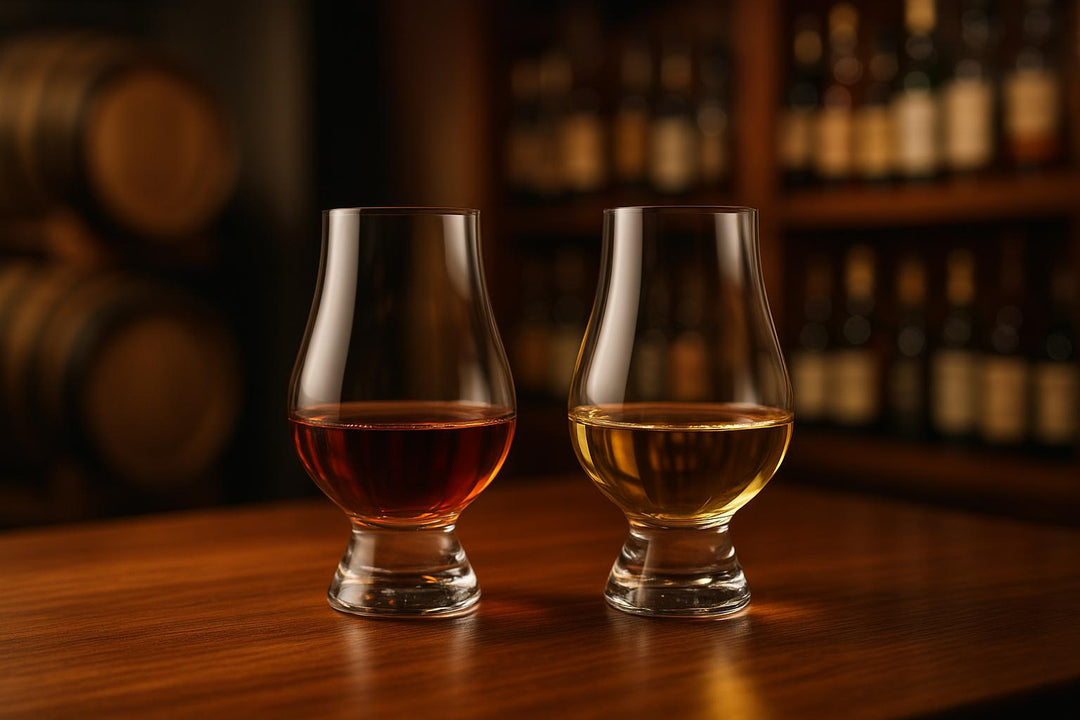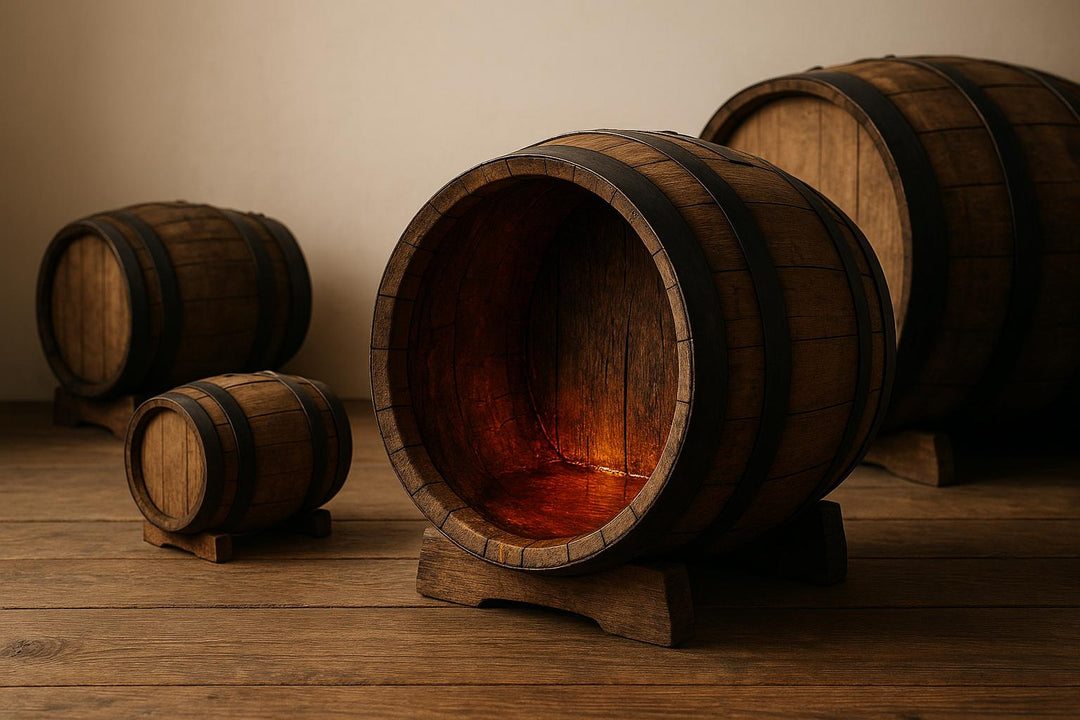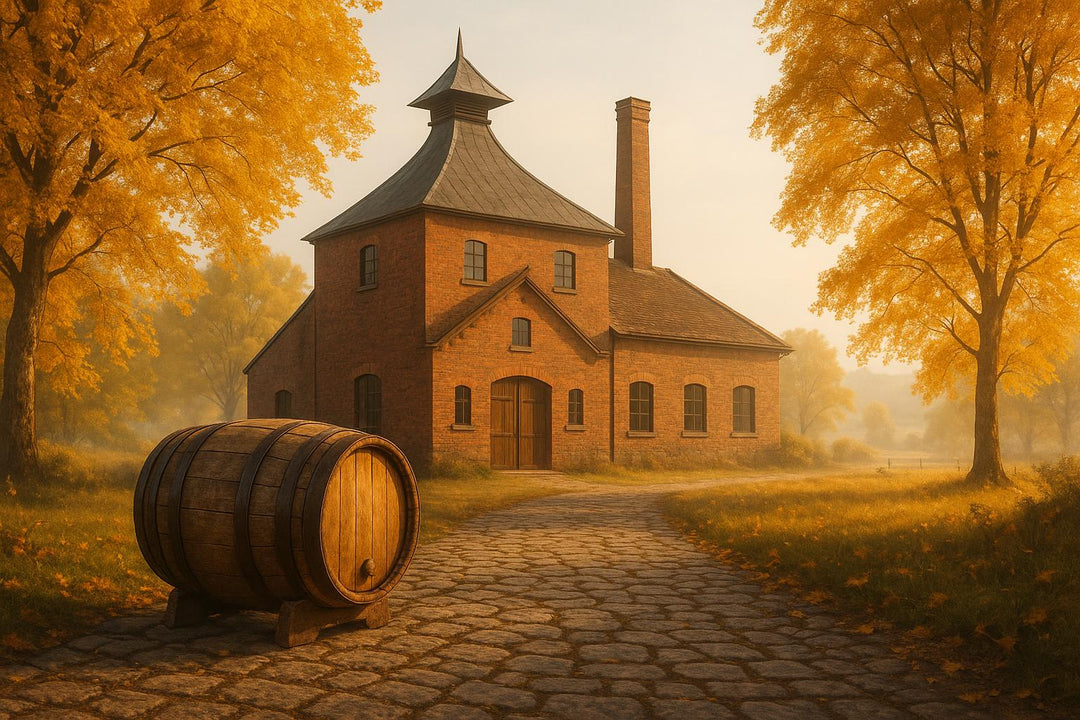Malting is a critical process in whisky production, transforming raw barley into fermentable sugars that yeast can convert into alcohol. It involves three main steps: steeping (soaking barley to increase moisture), germination (allowing the grain to sprout and develop enzymes), and kilning (drying the malt to halt growth and influence flavour). This process not only prepares the barley for fermentation but also shapes the whisky's flavour profile.
Malting dates back thousands of years, with evidence of its use in early civilisations like the Natufians and Egyptians. By 2500 BC, malting practices had reached the British Isles, where they evolved significantly over time. Monks in medieval Scotland and Ireland refined malting and distillation, laying the groundwork for modern whisky production. Historical records from 1494 in Scotland and 1405 in Ireland highlight the importance of malted barley in producing spirits.
The Industrial Revolution introduced mechanised malting methods, replacing labour-intensive floor malting with systems like Saladin boxes and Germination and Kilning Vessels (GKVs). These advancements improved consistency and efficiency, though some distilleries still use older methods to maintain specific flavour characteristics. Today, malting remains a balance of preserving heritage techniques while utilising modern systems to meet global demand for whisky.
Early Origins of Malting Practices
Malting in Early Civilisations
Malting has roots that stretch back thousands of years, far earlier than the advent of whisky. Archaeological evidence from the Natufian culture shows that as far back as 13,000 years ago, people were sprouting and heating grains - an early step in crafting ingredients for beverages.
The methods were rudimentary but demanding. Grains were soaked in baskets, then spread out on rock slabs or mats to sprout. To ensure even germination, the grains needed constant turning. Drying was done either under the sun or over open fires, a process that occasionally infused a smoky character into the malt.
The Egyptians took these practices a step further. They steeped grain in wicker baskets, which were lowered into wells and then raised to manage germination. This method allowed them to control moisture levels with precision, ensuring more consistent results. Such advancements not only improved the quality of malt but also set the stage for its use in beverages, including those that would eventually lead to distilled spirits.
These early experiments and techniques paved the way for malting's journey to the British Isles.
Malting Arrives in the British Isles
In Britain, the history of malt production stretches back to around 2500 BC, during the Neolithic period. This long tradition highlights how deeply embedded malting became in the region's culture.
By the Romano-British period, archaeological finds suggest that structures known as corn-driers may have doubled as malting kilns. These permanent installations marked a shift from the temporary setups of earlier times, reflecting a growing sophistication in the process.
By the high medieval period, malting had become a well-documented practice, particularly in monastic communities. Records from Battle Abbey, dating to around 1190, describe malting as a long-standing activity carried out by monks. An inventory from 1386 in Essex even lists tools specifically used for malting, evidence of how widespread and organised the practice had become.
Monks played a pivotal role in refining malting and distillation techniques, particularly in Scotland and Ireland. The term whisky itself originates from the Classical Gaelic word uisce, meaning "water" - a nod to the spirit's deep connection to Celtic traditions.
The first official mention of distilling in Scotland appears in 1494 within the Exchequer Rolls:
"Eight bolls of malt to Friar John Cor wherewith to make aqua vitae"
This entry refers to enough malted barley to produce nearly 1,500 bottles of spirit, suggesting that large-scale distillation was already well-established. Its inclusion in official records indicates this was no experimental endeavour but a recognised and organised production.
Ireland's distilling history is similarly ancient. The oldest known reference to distilled spirits there dates back to 1405, further demonstrating how malting had become integral to spirit production across the British Isles by the late medieval period.
These early developments form the backbone of modern malting practices. What began as a basic method of processing grain evolved into a refined craft, shaping an industry that would become central to both Scottish and Irish heritage. From its humble beginnings, malting laid the foundation for whisky-making traditions that endure to this day.
Malting Development in Scotland
From Basic to Advanced Practices
During the 16th and 17th centuries, malting in Scotland underwent a remarkable transformation. Early methods were rudimentary and often produced uneven results. The shift began with the dissolution of monastic life, as monks - displaced from their religious roles - brought their deep knowledge of malting into local communities. Their expertise introduced a focus on consistency and precision, which became the cornerstone of improved malting techniques.
The monks emphasised key factors like precise timing, careful temperature control, and meticulous handling of the grain. Floor malting emerged as the dominant method, with barley spread across large floors and turned by hand using wooden shovels. This process, though labour-intensive, ensured even germination and became the standard practice of the time.
Kilning methods also saw significant advancements. With limited access to wood in some regions, Scottish maltsters began using peat as a heat source. Not only was peat readily available, but it also added unique flavours to the malted barley. This distinctive characteristic would later become a hallmark of Scottish whisky. These developments laid a foundation for further innovations, some of which were driven by external pressures.
How Illegal Distilling and Taxes Changed Malting
The evolution of Scottish malting practices didn’t stop there. In the late 17th century, heavy taxes on malt and distilled spirits imposed by the Scottish Parliament dramatically altered the industry. Many distillers were forced into illegal operations, which in turn spurred a wave of creativity and adaptation.
By 1780, the numbers told a striking story: while there were only about eight legal distilleries in Scotland, an estimated 400 illegal ones thrived. By the 1820s, excise officers were seizing around 14,000 illicit stills each year [1]. To avoid detection, illegal maltsters developed portable equipment and hidden kilns, ensuring their operations remained efficient and discreet.
The rugged Highland terrain played a key role, offering natural concealment for these underground activities. Local communities often supported or shielded the illicit distillers, creating an environment where innovation flourished. Maltsters refined their techniques to maximise barley yields while conserving fuel, a necessity in their covert operations.
Interestingly, this period of widespread illicit activity had a lasting impact on the industry. Many legal distilleries established after the Excise Act of 1823 were located on former illegal sites, benefiting from their strategic locations and the hard-earned expertise of their predecessors. The resourcefulness born during these challenging times became a cornerstone of modern Scottish malting practices, shaping the industry as we know it today.
sbb-itb-128d6c1
Industrial Revolution and Modern Malting
The Excise Act 1823 and Legal Distilleries
The Excise Act of 1823 marked a turning point for the whisky industry. By lowering taxes and introducing licences, it legitimised operations that had previously been run underground.
Distillers could now operate legally by paying a £10 licence fee and a charge per gallon of whisky produced. The results were immediate - smuggling, which had been rife, dwindled almost entirely within a decade.
George Smith, the founder of The Glenlivet, became the first licensed distiller in Speyside under this new law in 1824. His bold decision to go legitimate, despite threats from illegal competitors, highlighted the transformative potential of the Act. Smith’s success inspired others to follow his lead, resulting in a surge of legal distilleries across Scotland.
The Act achieved three key goals: it levelled the playing field for distillers, provided a steady income for Scottish grain farmers, and guaranteed consumers a consistent, high-quality product. With legal protections now in place, distillers could focus on refining their craft instead of evading authorities. This shift paved the way for the development of distinct regional styles and advancements in production techniques, including more sophisticated malting methods. In essence, the Act laid the groundwork for Scotland’s rise as a world leader in whisky production.
This new legal framework also opened the door to technological innovations that would revolutionise malting processes.
Changes in Malting: From Floor to Machine Methods
The Industrial Revolution brought sweeping changes to malting, replacing traditional, labour-intensive methods with mechanised systems designed for efficiency and consistency.
One of the earliest breakthroughs came in the late 1800s with the introduction of Saladin boxes. These systems automated the germination process, using mechanical turners to aerate the barley and allowing for the processing of large batches - up to 200 tonnes at a time. While revolutionary at the time, Saladin boxes eventually gave way to even more advanced technologies.
Modern malting now relies on systems like rotary drums, ideal for smaller batches, and Germination and Kilning Vessels (GKVs), which combine both processes in a single unit. GKVs represent the peak of efficiency, enabling precise control over every stage of malting while maintaining high standards of quality.
These innovations provide a stark contrast to traditional methods, offering a direct comparison between the old and new approaches.
Old vs New Malting Methods
The evolution from traditional to modern malting methods highlights the trade-offs between tradition and technology, with each approach offering its own strengths and limitations.
| Feature | Traditional Floor Malting | Modern Industrial Malting |
|---|---|---|
| Flavour Complexity | Greater potential for unique, smoky nuances | Predictable and controlled flavour profiles |
| Consistency | Results can vary | Highly consistent outcomes |
| Scalability | Limited to small-scale production | Designed for large-scale operations |
| Labour Intensity | Requires significant manual effort | Minimal human labour involved |
Supporters of traditional floor malting often argue that it enhances the grain's ability to absorb phenols - a key component of the smoky flavour in many whiskies. During kilning, the grain’s moist surface captures phenols from peat smoke, introducing flavours ranging from medicinal and tar-like to hints of seaweed. These phenols, including compounds like cresols and guaiacol, are what give certain whiskies their distinctive character.
On the other hand, modern mechanised malting dries the grain using warm air, which changes the conditions for flavour development. While this method might not produce the same depth of smoky complexity, it ensures unparalleled consistency and efficiency, reducing the variability associated with floor malting.
Today, only seven single malt Scotch whisky distilleries still use traditional floor maltings, a testament to how dominant modern methods have become. Even so, the debate between preserving tradition and embracing innovation continues. Many distillers argue that traditional methods bring an irreplaceable character to their whisky.
Modern techniques also allow for precise control over phenol levels in malted barley, measured in parts per million (ppm). For example:
- Very heavily peated malt: 50–170ppm
- Heavily peated malt: 30–50ppm
- Medium peated malt: 15–20ppm
- Lightly peated malt: 1–5ppm
Such precision would have been unthinkable with traditional methods, showcasing how far malting has come in balancing flavour and consistency.
Conclusion: Malting's Past and Future
Malting in whisky production is a fascinating blend of tradition and modern innovation. From its ancient, labour-intensive beginnings to today's precision-engineered systems, it continues to be a cornerstone in crafting whisky's complex flavours.
Balancing Heritage with Modern Approaches
The whisky industry is navigating an intriguing crossroads where age-old practices meet cutting-edge technology. A handful of distilleries - fewer than ten - still operate their own malting floors, producing between 15% and 30% of their malt requirements using traditional methods. This hybrid strategy allows them to honour their heritage while scaling up to meet contemporary demands.
Tradition, however, doesn’t mean resisting progress. Many distilleries are now adopting advanced maturation techniques that optimise wood usage and fine-tune processing conditions to achieve a broader flavour spectrum. The rise of data analytics and AI-driven tools has also revolutionised experimentation, enabling distillers to monitor and adjust variables with a level of precision that would have been inconceivable in the era of manual malting.
Looking forward, the global whisky market is thriving. It's projected to grow at an annual rate of 11.3% worldwide, with an even faster 15.3% growth rate in the UK. This surge is driven by trends favouring premium, authentically crafted spirits. The interplay of tradition and innovation not only elevates whisky production but also challenges producers to spotlight the unique methods that set their whiskies apart.
Celebrating Craft Through Expert Curation
As production evolves, expert curation plays a vital role in preserving whisky's heritage and character. The Really Good Whisky Company exemplifies this by carefully selecting premium malt whiskies that showcase the industry's deep-rooted traditions. Their curated collections span Scotch, Japanese, American, and other world whiskies, highlighting how diverse malting techniques contribute to distinctive flavour profiles.
Their offerings go beyond selecting exceptional whiskies. Bespoke bottling services and custom labelling allow enthusiasts to delve into unique expressions, often reflecting specific malting traditions from particular regions or eras. Whisky tasting packs further enrich this experience, offering a hands-on way to explore how malting methods influence taste.
In an industry where the past and future constantly intersect, the goal isn’t to choose between heritage and progress. Instead, it’s about finding the perfect harmony - honouring time-tested traditions while embracing sustainable, forward-thinking innovations that ensure whisky’s legacy endures for generations to come.
FAQs
Why is peat smoke such an iconic feature of Scottish whisky?
Peat smoke plays a key role in shaping the flavour of Scottish whisky, thanks to its historical use in drying malted barley. In Scotland, peat - a dense, organic material formed over centuries - was abundant and easy to source, making it a practical fuel for kilning. When burned, peat releases phenolic compounds, which are responsible for the smoky, earthy notes that many people associate with traditional Scotch whisky.
This practice became especially significant in places like Islay, a region renowned for its heavily peated whiskies. These whiskies are celebrated for their bold, smoky character. The level of smokiness in the final product depends on how long the barley is exposed to peat smoke during the malting process, making it a signature feature of certain Scotch whiskies.
How did the Industrial Revolution change the malting process in whisky production?
The Industrial Revolution completely reshaped the way malting was done in whisky production. Thanks to the introduction of automation and advanced machinery, the process became significantly more efficient and reliable, paving the way for distilleries to scale up their operations.
Manual, labour-heavy floor malting was gradually replaced by automated systems. These new methods not only made the process less taxing but also allowed for greater precision, resulting in malts that were lighter and had less of the smoky flavour traditionally associated with whisky. This change aligned perfectly with shifting consumer preferences. On top of that, innovations like the continuous still played a key role by enabling higher production volumes and standardising techniques, laying the foundation for the modern whisky industry.
Why do some distilleries continue to use traditional floor malting instead of modern methods?
Some distilleries stick to traditional floor malting because it allows maltsters to rely on their senses - sight, touch, and smell - to carefully oversee the process. This hands-on method can draw out flavours that are often difficult to replicate with modern machinery, giving the whisky a unique character.
Beyond flavour, floor malting keeps alive a sense of heritage and artisanal skill, tying the whisky to age-old practices. For many, it’s not just about making whisky; it’s about respecting the history and authenticity that true whisky lovers hold dear.







Leave a comment